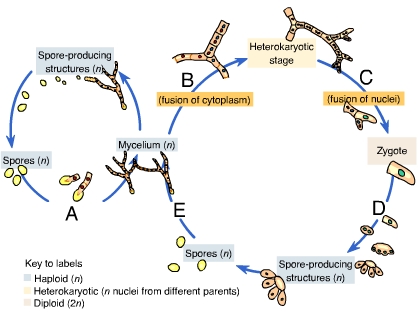What is the difference between heterokaryotic and dikaryotic organisms?
Microorganisms are mainly classified as eukaryotic and prokaryotic. But they can also be grouped as heterokaryotic and dikaryotic.
The main difference between dikaryotic and heterokaryotic is that dikaryotic cell has two genetically different nuclei while the heterokaryotic cell has two or more genetically different nuclei.

Comparison Table between Heterokaryotic and Dikaryotic
| Basic Terms | Heterokaryotic | Dikaryotic |
| Description | It is a cell that contains two or more genetically different nuclei in a cytoplasm | It is a fungal cell that has two genetically different nuclei in a cytoplasm |
| Number of Nuclei | Two or More nuclei | Two different nuclei |
| Unique to Fungi | Not unique to fungi | Unique to fungi |
| Examples | Mycelium of fungi and hybridoma technology | Ascomycota ascogeneous hyphae and ascocarp |
What Is Heterokaryotic?
Heterokaryotic is a biological term used to define organisms that have two or more genetic different nuclei in the same cell.
It is also known as heterokaryon which implies multinucleated cells. The cell is a result of the fusion of two genetically different cells.
The two different cells come into close contact where the plasma membrane fuses with each other to form a single cell.
The cytoplasm of the heterokaryon will contain both the donor nuclei. The phenomenon is quite common in fungi during sexual reproduction.
What Is Dikaryotic?
Dikaryotic is a biological term used to describe an organism that has exactly two genetically distinct nuclei.
It is also known as dikaryon which occurs as a result of plasmogamy. It is a unique feature in fungi.
Plasmogamy is an initial sexual reproduction in fungi. The phenomenon tends to bring two nuclei together for fusion.
The new cell stage formed after fusion results in cell genetics that are different from the normal haploid or diploid cells.
The dikaryotic phase results in a cell that contains both male and female nuclei coexisting within the same cytoplasm.
Main Difference between Heterokaryotic and Dikaryotic In Point Form
- Heterokaryotic has two or more genetically different nuclei in the same cell whereas dikaryotic has exactly two genetically different nuclei in the same cell.
- Heterokaryotic has two or more nuclei cells whereas dikaryotic has exactly two nuclei cells.
- Heterokaryon is not unique in fungi whereas dikaryon is unique in fungi
- Examples of heterokaryon are mycelium of fungi while that of dikaryon is Ascomycota ascogeneous hyphae and ascocarp.
Similarities between Heterokaryotic and Dikaryotic
- Both are an organism that comprises of two genetically different nuclei
- Both organisms have the same cytoplasm
- Both are common in the fungi
- Both structures are produced as a result of sexual reproduction
You May Also Like:
- Difference between Eukaryotic Cell and Prokaryotic Cell
- Difference between Prokaryotic and Eukaryotic DNA
- Difference between Prokaryotic and Eukaryotic Transcription
- Difference between Prokaryotic and Eukaryotic Chromosomes
Comparison Video (Heterokaryotic Vs Dikaryotic)
Summary
The core difference between heterokaryotic and dikaryotic is that heterokaryotic has two or more different nuclei in the same cytoplasm whereas dikaryotic has exactly two different nuclei in the same cytoplasm.
More Sources and References
- Dikaryotic. Wikipedia
- Heterokaryotic. Wikipedia